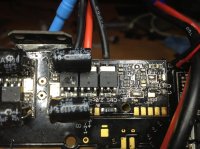JLO
Member
Hi guys I was on the power up for the first time a new all Mk electronics package MK FC 2.0, octo xl power dist board Bl-Ctrlv2.0 pre solder by the dealer,Mk Navi board , and MkGPS
and as soon as I connected a 4S lipo something POP and the distinctive electronic smell and of course the "O NOO from me, after inspection the only visible damage was a hole on 1 of the mosfets on the bottom of the board next to the caps BL-Ctrl #8, I have inspected and inspected all of the solders that I did and I did not see any mistake tomorrow I am calling the dealer but for now my question is has this happen to any one before if so why. thanks guys
View attachment 9886
and as soon as I connected a 4S lipo something POP and the distinctive electronic smell and of course the "O NOO from me, after inspection the only visible damage was a hole on 1 of the mosfets on the bottom of the board next to the caps BL-Ctrl #8, I have inspected and inspected all of the solders that I did and I did not see any mistake tomorrow I am calling the dealer but for now my question is has this happen to any one before if so why. thanks guys
View attachment 9886

